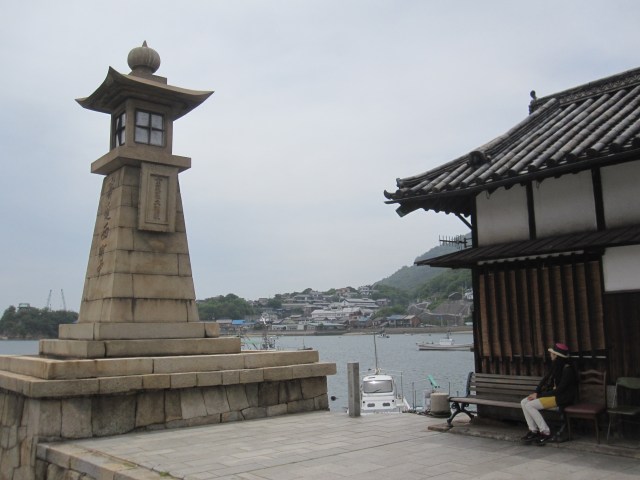
With her unique mix of weird and cute, you’d be hard-pressed to find an animation fan who doesn’t recognize Ponyo, the fish-girl from legendary director Hayao Miyazaki’s 2008 film of the same name. On the other side of the Pacific, justabout anyone with even a passing interest in comics at any point in the last 40 years knows who Marvel’s Wolverine is.
While one character is a symbol of innocence and whimsy, and the other of machismo and toughness, Ponyo and Wolverine’s paths have actually crossed, in a small fishing port called Tomonoura, where the mutant superhero made such an impression on the locals they named a rose after him.
And no, this isn’t fanfiction we’re talking about.
Tomonoura is part of Fukuyama City, which is itself located in Hiroshima Prefecture. The downtown area is developed enough to warrant its own stop on the Shinkansen bullet train line, but if you’re headed to Tomonoura, you’ll need to take a 30-minute bus ride from Fukuyama Station.
Because of its position on the Setonaikai Inland Sea, Tomonoura used to be a fairly important harbor for merchants transporting cargo between the central and western regions of Japan. Much of this changed with the introduction of trains, as well as the development of sturdier ships and advanced navigation techniques, allowing captains to bypass the Inland Sea in favor of quicker routes through open waters.
Today, Tomonoura is a quiet, relatively isolated neighborhood that’s home to the remaining fishermen who dock there. But while Tomonoura no longer attracts the merchant vessels it used to, its picturesque alleyways, historic structures, and timeless coastal scenery have been pulling filmmakers to the town, including Miyazaki.
Prior to the official start of production on Ponyo, the Studio Ghibli founder spent two months in Tomonoura, soaking up the local atmosphere which he would later put to use in creating the town where Sosuke, Ponyo’s first human friend, lives. This is obviously an extremely big feather in the cap of the little port, as evidenced by the well-stocked selection of Ponyo merchandise proudly displayed in the visitors center.
Tomonoura was also used by idol megagroup AKB48 when it came time to film the music video for their very first song done in the traditional enka style.
The neighborhood even caught the eye of Hollywood, serving as one of the locations for the Hugh Jackman action film The Wolverine. Known in Japan as Wolverine: Samurai, the 2013 picture sees the titular superhero traveling first to Tokyo to visit a dying friend, then fleeing with the man’s granddaughter, named Mariko, when she’s targeted by assassins. When Wolverine and Mariko go on the run, they get off the Shinkansen at Fukuyama Station, passing by some of the city’s famed roses. In appreciation of the honor, local botanists developed a new breed of the flower which they dubbed the Wolverine Fukuyama.
Wolverine and Mariko later take refuge in her ancestral hometown. While the movie’s dialogue indicates they’re near Nagasaki, the visuals tell a different story, as they get off the bus next to Tomonoura Port.
▼ Just standing here for more than a few seconds will add two inches to your sideburns.
You won’t find any mutants or anime characters wandering the streets of Tomonoura, though. Instead, you’ll find the sort of rustic architecture that’s brought the neighborhood its repeated bursts of modest fame.
Tomonoura’s most recognizable symbol is the Joyato Lighthouse, which stands at the edge of the port. The structure was built during the Edo Period, making it at least 150 years old.
There’re also a few cultural landmarks scattered about, such as Fukuzenji Temple, which is located up a short flight of stone steps from the main road that runs along the waterfront.
From its vantage point on the slope, Fukuzenji affords visitors a panoramic view out over the strait and nearby islands.
The cooling sea breeze blowing through the open windows is an added bonus.
In the center of town are a very small number of restaurants and stores selling handicrafts.
You’ll also come across a few shops specializing in homeishu, a medicinal liquor Tomonoura has long had a reputation for
▼ A homeishu seller, demonstrating the well-known marketing principle that one of the best ways to advertise anything is with awesome wood-carved dragons.
On the far side of the harbor from the bus stop, the roads start to incline. Halfway up the hill is Ioji Temple, which boasts even more expansive views of the surrounding area than Fukuzenji.
Another 15 minutes of walking uphill leads to the Taishiden Hall and lookout point. However, if you’re already sweaty enough, or, like we were, worn out from biking across the Inland Sea from Shikoku, multiple paths will take you back down to the harbor instead.
While admiring the view from Fukuzenji or Ioji, you’ll probably notice two islands. There’s no way for tourists to access Bentenjima, the smaller one with the noticeable pagoda, but Sensuijima, the larger island beyond it, is a different story.
Boats depart for Sensuijima from Tomonoura’s ferry terminal three times an hour. A round-trip ticket for the five-minute voyage costs just 240 yen (US $2.40).
Sensuijima has a hotel, restaurants, camp ground, and foot bath hot spring. Of more interest to most day trippers, though, are the walking courses that go over and around the island, leading to observation decks and some ruggedly beautiful coastline.
After a leisurely stroll around the base of the multi-colored cliffs, we caught the ferry back to the mainland. As we settled in for our bus ride back into downtown Fukuyama, we couldn’t help but wonder how Wolverine, a guy who clearly could use a break after all the trauma and turmoil he’s been through, could leave such a relaxing place behind.
▼ Ponyo, on the other hand, seems to have decided to stick around.
Photos ©RocketNews24